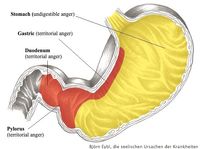Gastric mucosa, pylorus and duodenum
The gastric mucosa, pylorus and duodenum all belong to the territory area, see also ectoderm. The location of impact in this area of the brain depends on the gender, biological laterality and hormone status of the person.
More explanation and information during the online workshop Biological Behaviour and Character.
Also see liver and bile ducts, stomach, duodenum.
Sensitivity follows the gullet mucosa pattern.
Theme
Territory anger and identity conflict.
- Anger, seeing someone as a threat or regarding a threatening situation.
- Not knowing where you belong or with whom, not being able to make a decision.
CA phase
Functional increase. Decrease of the mucous membranes of the stomach, pylorus and duodenum.
Muscle weakness of the underlying transverse muscles.
Biological purpose
Thinner mucous membranes, weaker muscles. Enlargement of the stomach, pylorus and duodenum.
Symptoms
Pain in the stomach area, gastric ulcers, heartburn. Opening of the sphincter of the gastric entrance allows gastric juice to enter the esophagus.
Prolonged conflict activity: stomach sufferers (see also stomach)
PCL phase
Functional normalization. Rebuilding of the mucous membranes.
Symptoms
Possibly black(ish) stool due to bleeding ulcer.
EC
Acute, severe pain due to the EC of the striated muscles of the stomach, gastric colic, gastric bleeding (black stools), absence, chills, cold sweat, heartburn.
Constellation with laryngeal mucosa (scare fright + territory anger): autism.
Smaller territory for better overview.
Constellation with rectal mucosa (identity + territorial anger): aggression.
The territory must be defended!
More information during the online workshop Bio-Logic of Behavior and Character.
A combination of this program in the active phase of a fear-disgust conflict can cause bulimia.

